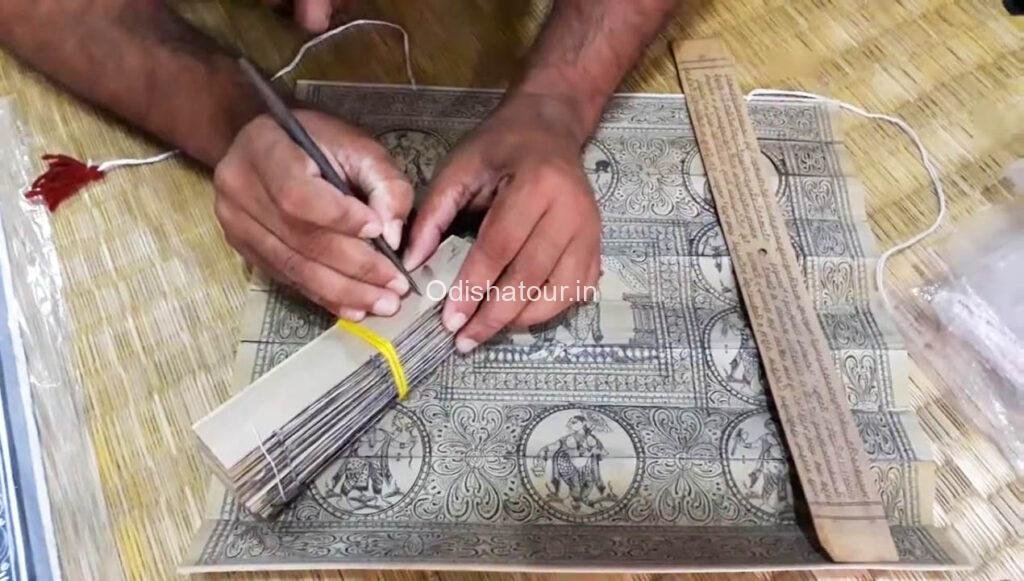
The palm-leaf is an ancient record of Odisha. It contains, Mantra, yantra, tantra, religion, architecture, medicine, astrology, astronomy, grammar details of war arms and armoury, geography, trade routes, occult practices, temple rituals, crafts, literature and so on. This leaf- speaks about every aspect of the life of Odian culture and livelihood.
Everything that the Odisha alphabets have no headmarks like that of Bengali or Nagari script, can safely be attributed to the long and continuous practice of writing on palm leaves. The stones of the Konark, Mukteswar and Rajarani temples of Bhubaneswar display the union of the couple, and the Amara Sataka and the Gita Govinda Palm leaf manuscripts describe the monuments of love. Here the passion has been translated both in words and forms.
The Odisha artist has shown their excellence in these miniature paintings in the palm leaf. Unique in their style and forms, artisans have constituted a significant part of the glorious Odissian tradition and are similar to the tradition of dance and sculpture. The features of human figures as well as the flora and fauna are sharp and well proportioned and display the same precision and neatness with which one can find the motifs, drown in the textiles in the typical Odisha tie and dye tradition.
The epigraphic evidence of the use of palm leaf begins in the Sixth century AD and during the reign of the Kurud, Charter of Maharaja Narendra, who issued his camp of victory on palm leaf and found at Tilakeswar records, the renewal of the grant of village Kesavaka. This village had been formerly granted in a palm-leaf character to one Bhasrutaswami by the previous king, but as the palm-leaf was destroyed in the fire, Maharaja Narendra regranted it in a copper plate charter in favour of Sankhaswami, Son of Bhasrutaswami. Maharaja Narendra was a Sarabhapuriya king of South Koshala in the 6th century AD.
There is also so much sculptural evidence regarding the use of palm-leaf manuscripts. The earliest of these can be found in the Parsurameswar temple at Bhubaneswar near Kedar-Gouri which was built during the rule of the Sailodbhava dynasty in the 7th century AD. Similar representations can be observed in the Mukteswar temple 10th century AD and also the famous Sun temple Konark in the 13th century AD. Another sculptural evidence is an image of Buddha found at a temple in Hirapur near Bhubaneswar.
In this sculpture, one can find the pedestal of a scholar studying some holy scriptures in the shape of a stringed palm-leaf manuscript placed on Vyasasana. There is a beautiful presentation of a scribe writing with a style on a palm leaf in a sculpture of the Jagannath temple at Dharakot.
The total Buddhist scripture Avatamsaka Sutra was written on a palm-leaf manuscript, and it was presented to Chinese Emperor Te-sang by Sudhakara Deva, the Bhoumakara king of Odisha, with his autography. It was an event of the 8th century AD.
The oldest datable palm-leaf manuscripts are found in the Odisha State Museum where one can also find the writings of Panchasakha to the Bhanja era. During the period Sarala Mahabharat by Sarala Das, Adhyatma Raman by Gopal Telenga, Haladar Das and Bichitra Ramayan by Biswanath Khuntia were also written in palm-leaf. Besides this Mathura Mangal by Bhakta Charan Das, Bidagdha Madhaba by Rupa Goswami and Rasakalola by Dina Krushna Das were also written bear the evidence of palm-leaf. Upendra Bhanja a brilliant poet has written volumes of Kavya Kavita in palm leaf which are now printed in books. As such before the introduction of paper, palm-leaf was the media of poets and prophets in Odisha. They wrote in Odia & Sanskrit of palm-leaf which are now called Pothi.
